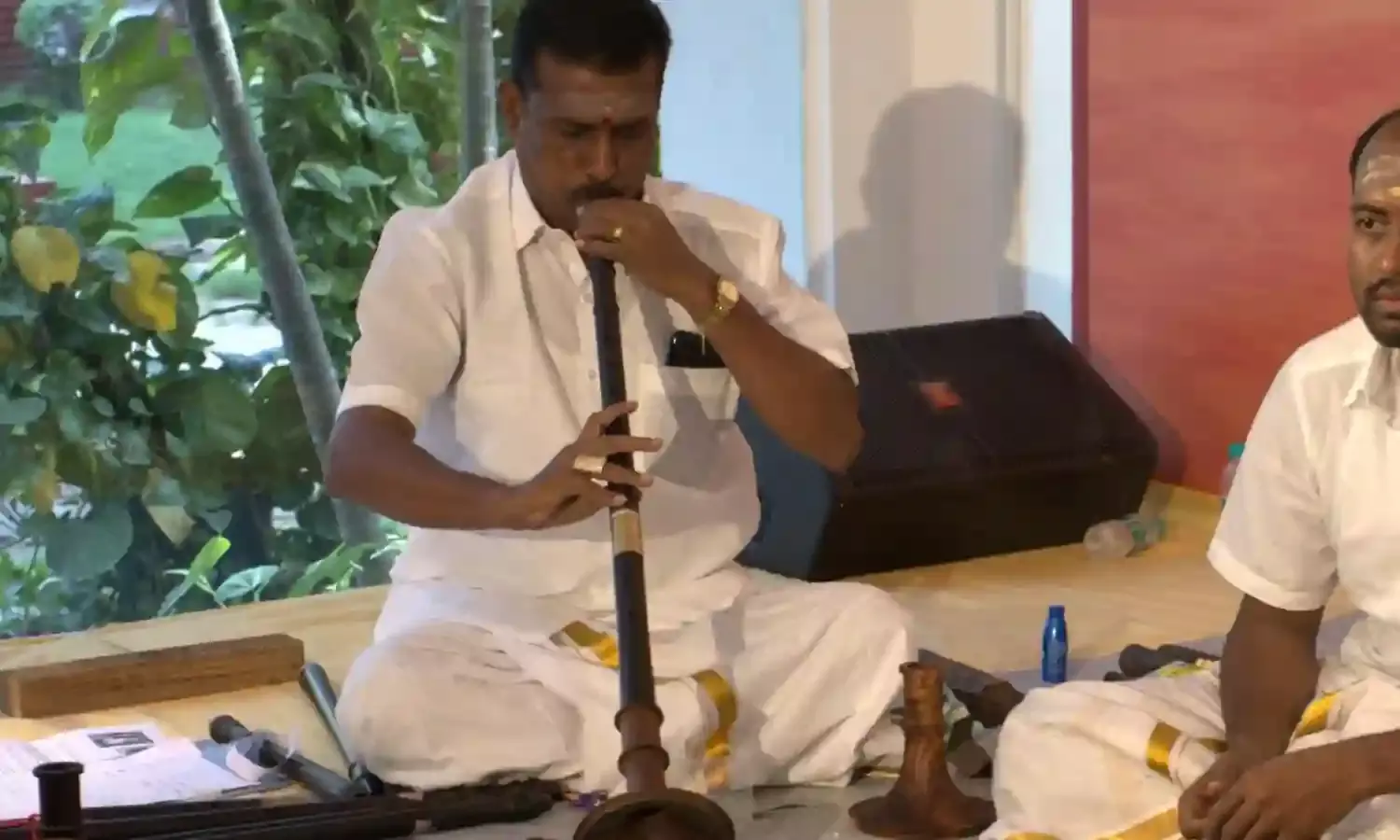Breathing Music into Wood
The nadaswaram makers of Narasingapettai

In a corner of the Lalit Kala Akademi Gallery, C. Satish and three of his companions are busy arranging some wooden blocks and tools. These fifth-generation nadaswaram makers from Narasingapettai, Tamil Nadu, have travelled all the way to New Delhi to showcase the process of producing a handcrafted instrument.
It is also a glimpse of the lives of artisans who still strive to keep these arts alive amidst an influx of music from around the world.
The nadaswaram is an ancient musical instrument that dates back to the early centuries CE. It finds mention in the Sangam literature of Tamil Nadu, and is one of the loudest non-brass acoustic instruments in the world.
There are only four to five families left in Narasingapettai who still carry on this craft. The transformation of the bulky Aacha tree (Hardwickia binate) and Vaagai tree (Albizia lebbeck) into the finely carved, light instrument is a tedious process achieved only by these finest craftsmen who continue this tradition, all by hand.
"The nadaswaram is an integral part of both Carnatic and folk music", says T. Somasundaram, an Academy Award winner for his contribution to folk arts. "It is considered very auspicious and is played at a wide variety of ceremonies like weddings, temple concerts, religious rituals and festivals. But at the same time, it is commonly played in folk dance dramas."
Some people suggest that the making of nadaswarams should be shifted to machines. But these artisans disagree. According to them, machine making has not proven to be a successful alternative. The finesse of the craftsmen makes for handmade instruments with better quality both in terms of the structure and the sound produced.
In March, the nadaswaram was given a Geographical Indication tag, which has gained some recognition for the makers as well, since usually the honour only goes to the artists who play the instrument.
"We are really happy that we were given an opportunity to come to Delhi and showcase our talent. This would help it spread to large parts of India and even worldwide. We also hope to get some government assistance to carry on with our livelihood," says Somasundaram.
These skilled craftsmen make 3-4 nadaswarams a month. The labour cost amounts to around Rs 4,000 per nadaswaram. "We do not make huge profits, but it is enough for us to survive and carry forward the craft," says Somasundram.
Satish, 29, carries forward the traditional method of nadaswaram making. Working nearby on the pattarai (wooden lathe) is his assistant, I. Karuppaiya. The lathe machine is an indigenously developed apparatus and operated manually by two persons using a rope
The artisans' tools kept in honour of the gods before the process of nadaswaram making begins. Different types of files and chisels are used throughout the carving process
Vaagaimaram, the wood of the rain tree is converted to the anusu, the flared end of the instrument. It is mounted on a wooden lathe and shaped to perfection. A 2 kg wooden block is transfigured into the anasu weighing 45-50 gms
After polishing the anusu with sandpaper (earlier coconut fibre or sand was used), oil is applied to the wood. The vaagai wood shows a distinct pattern and colour when oiled, and lasts over a 100 years. A perfectly finished anusu can be balanced on the floor at an angle
The making of the kuzhal (the pipe of the wind instrument) requires a great deal of chiselling of the aachai maram or Indian Blackwood. This wood prevents saliva from accumulating inside it while playing the instrument for long hours
The carved aachai wood is mounted and turned on the lathe till it is shaped into the kuzhal. Different types of files and chisels are used with great care to increase the precision of the instrument
The surface of the Kuzhal is smoothed using sandpaper. A finely shaped kuzhal is measured using the leaf of a coconut tree to determine the accuracy of the pipe
With the help of marker tools, and a metal scale, artisans make holes at equal intervals. A total of 12 holes are made; seven on the front and five additional at the bottom which help tune the nadaswaram
Once the marking process is completed, holes are drilled with a drilling tool
In the final stage of production, the anusu is joined to the kuzhal with brass bushes. A seevali (double reed) is attached to the tip of the nadaswaram for playing
A.Pandyaraj, a skilled maker and player of nadaswaram, fills the atmosphere with the popular classical song Sringaravelane Deva, a perennial favourite of young and old transcending time and age boundaries



